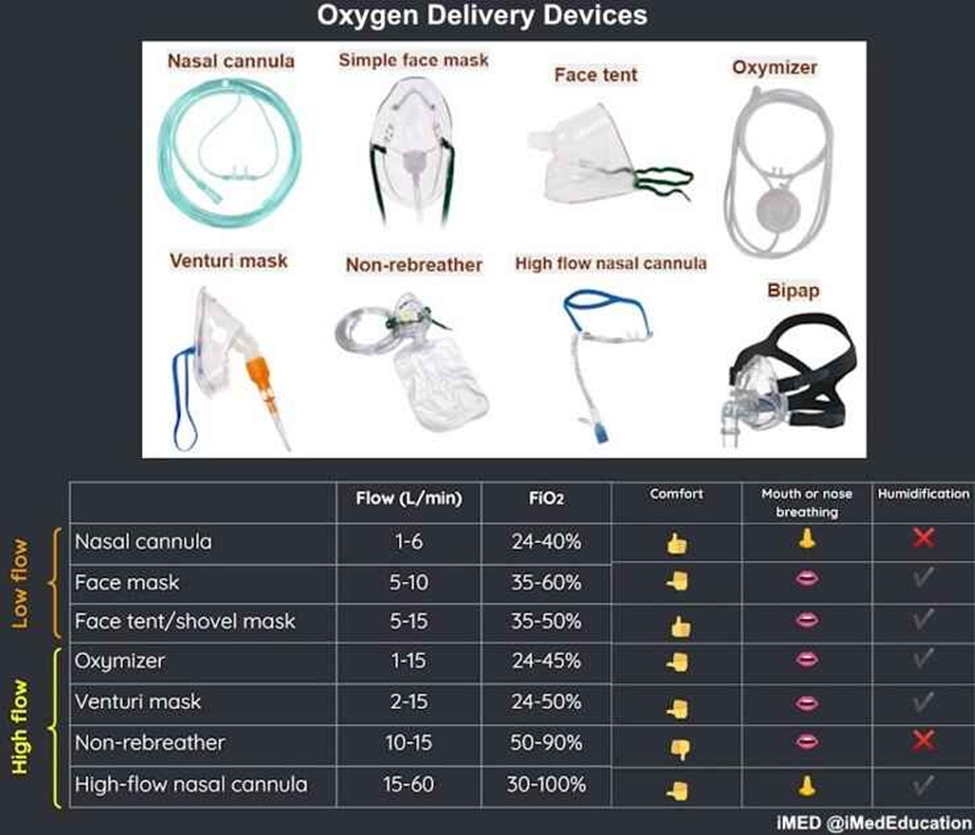The nurse is caring for a client who is experiencing mild shortness of breath during the immediate postoperative period, with oxygen saturation readings between 89% and 91%. What method of oxygen delivery is most appropriate for the client’s needs?
Partial non-rebreathing mask
Simple (Oxy Plus) mask
Nasal cannula
Non-rebreathing mask
The Correct Answer is C
A. Partial non-rebreathing mask:
This mask delivers higher concentrations of oxygen than a nasal cannula. It has a reservoir bag that allows the client to rebreathe some exhaled air, increasing the oxygen concentration delivered. However, it may not be necessary for a client with mild shortness of breath and slightly reduced oxygen saturation.
B. Simple (Oxy Plus) mask:
The simple mask provides a higher concentration of oxygen than a nasal cannula but lacks the reservoir bag found in the non-rebreathing mask. It is generally used for moderate oxygen needs. However, it might be more than what is required for a client with mild shortness of breath and slightly reduced oxygen saturation.
C. Nasal cannula:
Nasal cannulas are commonly used for clients with mild respiratory distress. They deliver a lower to moderate concentration of oxygen and are well-tolerated by most clients. They are suitable for individuals with mild shortness of breath and can be adjusted based on the required flow rate.
D. Non-rebreathing mask:
The non-rebreathing mask provides the highest concentration of oxygen among the options listed. It includes a reservoir bag to deliver a higher oxygen concentration. It is typically reserved for clients with higher oxygen requirements. For a client with mild shortness of breath and slightly reduced oxygen saturation, this may be more than necessary.

Nursing Test Bank
Naxlex Comprehensive Predictor Exams
Related Questions
Correct Answer is B
Explanation
A. Factor VIII: Factor VIII is a component of the clotting cascade, but it is not the antidote for warfarin. Factor VIII is used in the treatment of hemophilia A.
B. Vitamin K: This is the correct answer. Vitamin K is the antidote for warfarin overdose. It helps in the synthesis of clotting factors.
C. IVIG (Intravenous Immunoglobulin): IVIG is not an antidote for warfarin. It is used for various immune-related conditions.
D. Factor X: Factor X is also a clotting factor, but it is not the antidote for warfarin. Factor Xa inhibitors are used as anticoagulants.

Correct Answer is A
Explanation
A. “I will need to stop smoking because the nicotine causes less blood to flow to my hands and feet.”
Explanation: This statement reflects an understanding of the association between smoking and reduced blood flow, particularly due to nicotine's vasoconstrictive effects.
B. “The older I get the higher my risk for peripheral arterial disease gets.”
Explanation: While age is a non-modifiable risk factor for PAD, it is not a statement indicating a change in behavior to address risk factors. It is correct information but doesn't involve a proactive approach to risk reduction.
C. “Since my family is from Italy, I have a higher risk of developing peripheral arterial disease.”
Explanation: Family history is a non-modifiable risk factor, and the statement correctly identifies this risk factor. However, it doesn't address modifiable factors or actions to reduce risk.
D. “I will need to increase the amount of green leafy vegetables I eat to lower my cholesterol levels.”
Explanation: This statement demonstrates an understanding of a dietary modification to lower cholesterol levels, which is a positive step toward reducing a modifiable risk factor for PAD.
Whether you are a student looking to ace your exams or a practicing nurse seeking to enhance your expertise , our nursing education contents will empower you with the confidence and competence to make a difference in the lives of patients and become a respected leader in the healthcare field.
Visit Naxlex, invest in your future and unlock endless possibilities with our unparalleled nursing education contents today
Report Wrong Answer on the Current Question
Do you disagree with the answer? If yes, what is your expected answer? Explain.
Kindly be descriptive with the issue you are facing.
